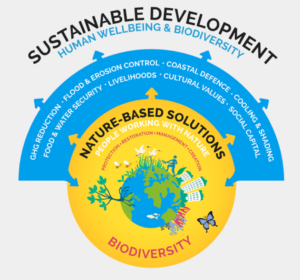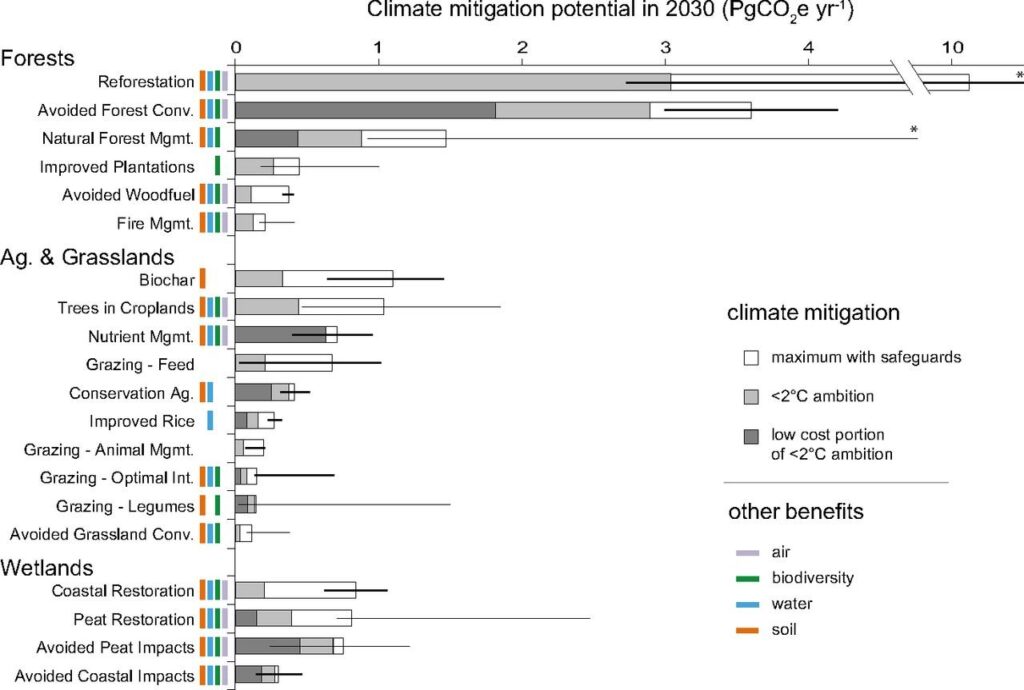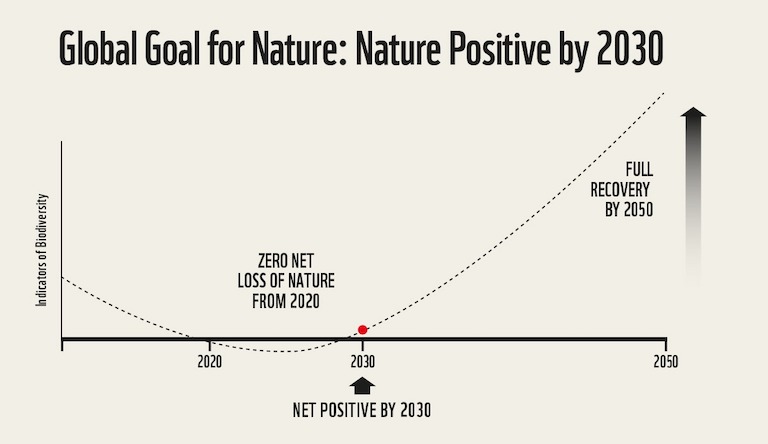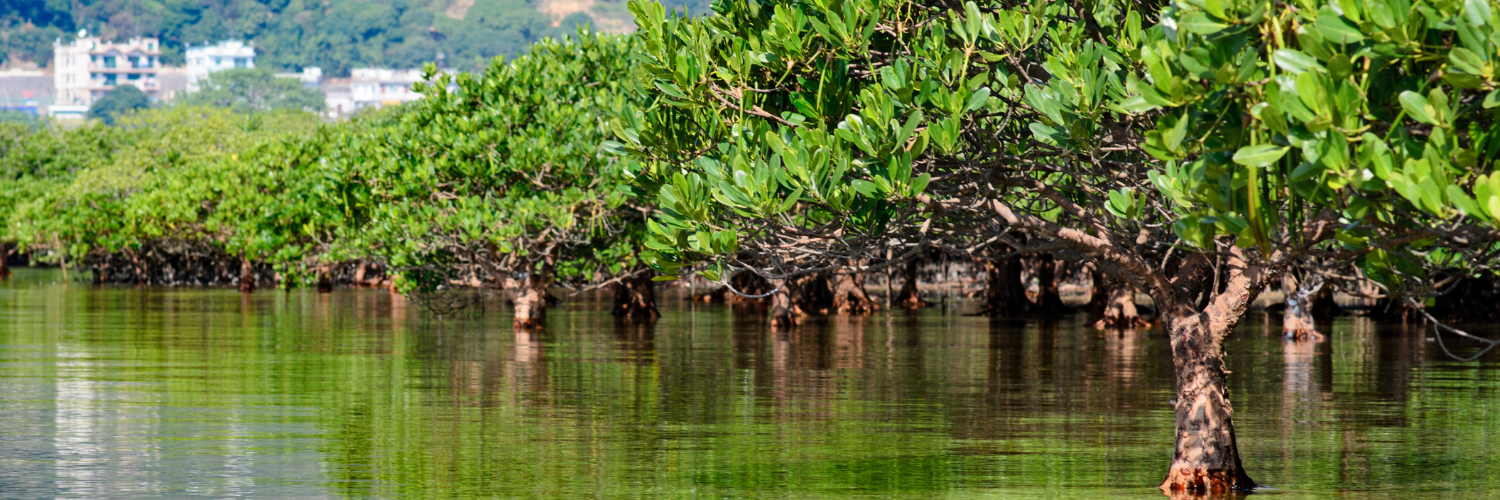Have you noticed the dizzying number of terms out there to describe the innovative work using nature to solve some of our most pressing environmental challenges? Nature based, natural climate, and nature positive are just a few of the phrases that have entered the vernacular of practitioners across many sectors from conservation to tech and politics. The language around this topic is becoming increasingly complex and nuanced, with multiple terms being used, often interchangeably. But what are the differences between these approaches and why does it matter?
The Urgency of the Moment
Our climate and biodiversity are facing dual interlinked crises. Experts have warned that if we do not act quickly on reducing our emissions, the Earth will warm beyond 2.0° C which will put humans and ecosystems in peril. More recently, one study found that about 30% of species have been globally threatened or driven extinct since the year 1500. With international agreements such as the Paris Agreement on Climate Change and the Post-2020 Biodiversity Framework marking major milestones for global cooperation, there is still a need for efforts to be coordinated to best meet these global goals. As more and more research shows that neither problem can be solved in a silo, there has been an urgent call to increase attention and resources on a tool that has been right in front of us all along—nature.
Conservation strategies that utilize nature can effectively and efficiently deliver dual climate and biodiversity benefits, all while building resilience for humans and ecosystems. As these strategies increase in popularity, so does the terminology being used to describe them. These terms have been quickly adopted by NGOs, corporations, governments, and individuals to communicate their work, which has led to a lack of clarity as to the differences between each one.
Let’s break down the differences between the three (there are a lot more) terms most commonly used in the field to help you navigate the nature-based vocabulary landscape.
Nature Based Solutions
The umbrella term that includes strategies that use nature to address a problem and deliver climate, biodiversity, economic, and/community health benefits.

The most popularly used term surrounding this issue is Nature-based solutions (NbS). This all-encompassing umbrella term is defined by the United Nations Environment Assembly (UNEA) as “actions to protect, conserve, restore, sustainably use and manage natural or modified terrestrial, freshwater, coastal and marine ecosystems which address social, economic and environmental challenges effectively and adaptively, while simultaneously providing human well-being, ecosystem services, resilience and biodiversity benefits.’’ First used in 2008 by the World Bank, the term has taken off in popularity, becoming mainstream in the worlds of business, conservation, politics, and more. Given the pace and scale of the adoption of this phrase, the term has faced widespread scrutiny from multiple groups. To address the critiques, measures of accountability are quickly becoming developed by third parties.
NbS can differ greatly in what they entail and address. Green infrastructure, ecosystem restoration, urban greening, coastal resilience projects can all be examples of NbS, though their ultimate goals may differ. What they have in common is that they are solutions that utilize nature to confront challenges faced by humans and ecosystems. The website Nature-Based Solutions can help you to break down some more of the different terms under the NbS umbrella.
Natural Climate Solutions (NcS)
A subset of nature-based solutions, that address a climate-driven problem and deliver climate change mitigation, adaptation, and/or resilience benefits, typically focused on emissions reduction or carbon capture using nature.

Under the umbrella of NbS, the term Natural-climate solutions is becoming more common as well. These strategies are part of NbS, but are activities that specifically aim to address a climate-driven problem and deliver climate change mitigation, adaptation, and/or resilience benefits, typically focused on emissions reduction or carbon capture through natural ecosystems (Nature4Climate). These actions should have measurable targets directly related to reducing or mitigating carbon emissions using nature, that ultimately contribute to the global Net Zero goal. Examples such as reforestation projects designed for carbon capture and regenerative agriculture that improves soil carbon can be included under the NcS umbrella.
One scientific study found that NcS have the potential to mitigate up to 37% of our carbon emissions, making them a powerful addition to the suite of tools being used to address climate change and meet the global goal of holding global average temperature rise below 2° C. NcS can link to carbon markets to receive innovative financing mechanisms, or report towards global emissions targets, which has spurred a great deal of interest in their ability to tackle the climate crisis.
Nature4Climate offers some great resources including this interactive map and a glossary of NcS terms.
It should always be noted that utilizing nature to address climate challenges cannot be a substitute for the rapid decarbonization of our industrial world. These strategies must be used simultaneously if we are to sustain our world as we know it.
Nature Positive
A global goal to halt biodiversity loss by 2030 and lead to a net increase of biodiversity by 2050.

In recent years, a new term has entered the dialogue: Nature Positive. As countries have been working to set targets for carbon emissions and sustainable development for years, it has become glaringly obvious that a similar time bound goal for nature to halt and reverse biodiversity loss is necessary. This term was originally introduced in 2021 when a group of experts came together to write "A Nature-Positive World: The Global Goal for Nature.” where they argue for the need to set rigorous and measurable targets for biodiversity recovery. In their paper, the authors introduced the goal of “three measurable temporal objectives: Zero Net Loss of Nature from 2020, Net Positive by 2030, and Full Recovery by 2050” as demonstrated by the image below.
Think of Nature Positive as the cousin of Net Zero. Where Net Zero specifically focuses on curbing carbon emissions, Nature Positive addresses biodiversity loss. There can be significant and impactful overlap between these strategies when used strategically. There are now many organizations and countries that have incorporated Nature Positive into their messaging and frameworks, the latest being the post-2020 Global Biodiversity Framework.
You may hear the term nature-positive solutions thrown around as well. Similar to natural climate solutions, nature positive “contributions” or “solutions” are what an individual entity can quantify of the maintenance and improvement of natural processes, ecosystems, and species over time at a project site, that ultimately contribute towards the global goal. Basically, individual entities cannot claim themselves to be “Nature Positive” but can contribute to helping reach this state through quantifiable actions that lead to an increase in biodiversity at a local scale. Check out Nature Positive by 2030 for more information on understanding the development of targets and standards if you want to learn more.
Language Matters
While the world has been strongly focused on climate goals for many years, biodiversity is at risk of being left behind. For years Nature-based solutions have drawn criticism from the conservation community, particularly when a project has detrimental impacts on an ecosystem or community, as well as inaccurately recording and claiming their contributions to carbon emissions. However, despite criticisms, the field is rapidly growing, with non-traditionally environmentally minded sectors such as business and tech beginning to invest large sums in nature. It’s critical for people, inside and outside the environmental field, to understand the differences between these terms and the strategies behind them. Just one example is that being able to appreciate the nuances will help consumers recognize egregious greenwashing and empower them to hold the transgressors accountable. What better way to stay on track to meet global goals?
Still curious about what the future of these strategies looks like? Join the Salazar Center at the fifth annual International Symposium on Conservation Impact in Denver, Colorado, on October 11 and 12. We will explore how nature-positive solutions can help address both climate and biodiversity goals, to help strengthen the resilience of communities and ecosystems across North America.

